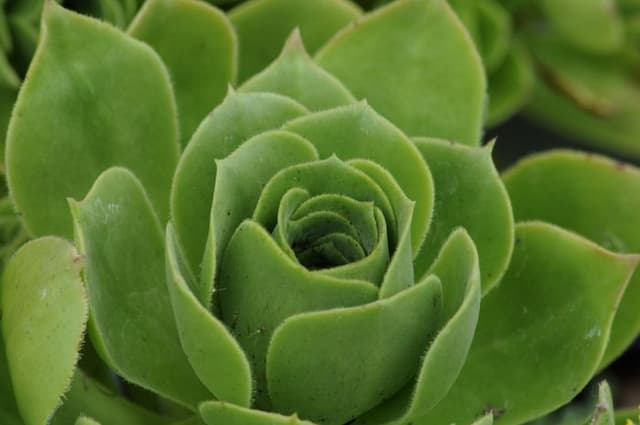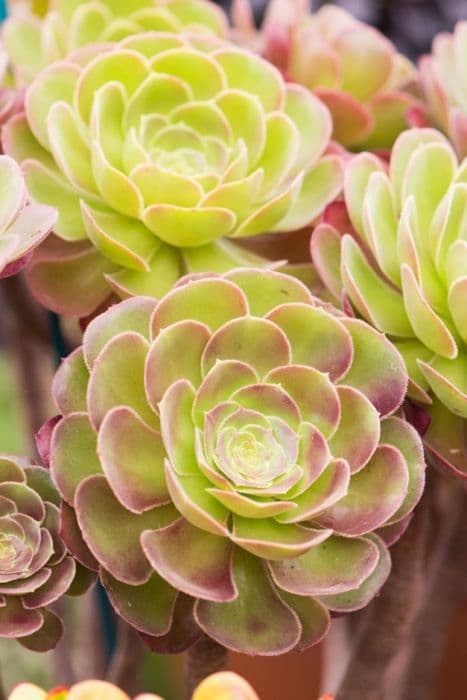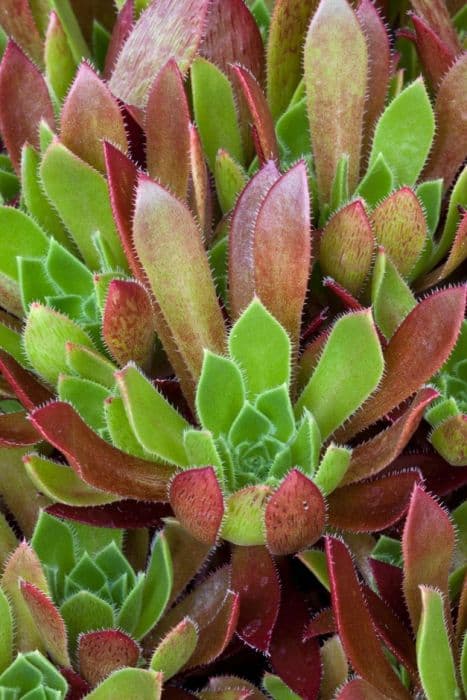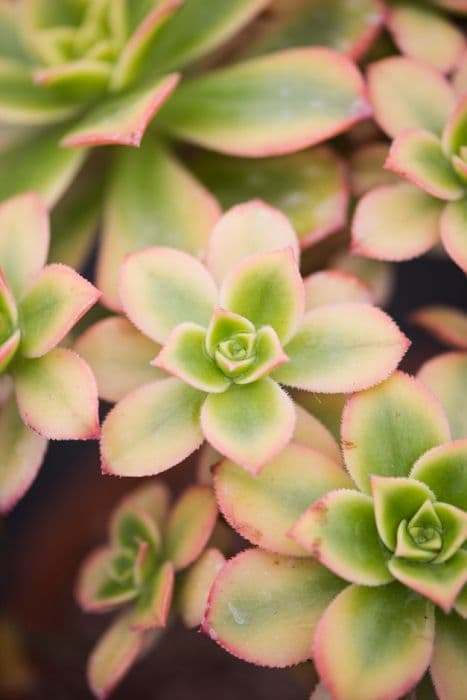Stonecrop Hylotelephium 'Veluwse Wakel'

ABOUT
The Hylotelephium 'Veluwse Wakel', commonly known as Stonecrop, is a resilient and attractive perennial plant that is popular in ornamental gardens. Stonecrop boasts fleshy leaves which are frequently arranged in a rosette pattern. The leaves of this variety are typically a green to blue-green color, sometimes with a dusky hue or a slightly purplish edge, depending on the light and environmental conditions. During its blooming period, Stonecrop produces clusters of small, star-shaped flowers that often appear in shades of pink, red, or mauve, adding a touch of vibrant color to the plant. These flowers are typically packed together in dense, rounded clusters at the ends of the stems, creating a visual impact that draws bees, butterflies, and other pollinators. The overall form of Stonecrop is a clumping habit, with stems that may sprawl or stand upright, forming a mound of lush foliage. The texture of the plant is quite distinctive due to its succulent leaves, which contribute to Stonecrop’s drought-resistant nature. Its appearance changes throughout the seasons, with some varieties displaying autumnal tones or a change in leaf color as the temperatures drop. Stonecrop is often utilized in rock gardens, as ground cover, or in borders due to its hardy nature and low maintenance requirements. It is well-suited to a range of soil types, and once established, it can tolerate periods of dry weather due to its water-storing leaves. In summary, Stonecrop 'Veluwse Wakel' is an appealing and easy-to-care-for plant that brings textured foliage and a splash of color to the landscape, offering year-round interest without the need for excessive care or watering.
About this plant
 Names
NamesFamily
Crassulaceae
Synonyms
Veluwse Wake Stonecrop, Wakel's Stonecrop
Common names
Hylotelephium ‘Herbstfreude’, Sedum telephium 'Autumn Joy', Sedum 'Herbstfreude', Sedum 'Indian Chief', Sedum 'Matrona', Sedum spectabile 'Brilliant', Sedum spectabile 'Carmen', Sedum spectabile 'Iceberg'.
 Toxicity
ToxicityTo humans
The plant Hylotelephium 'Veluwse Wakel' is commonly known as Stonecrop. Stonecrop is not considered highly toxic to humans, but it may cause mild discomfort if ingested. Symptoms are usually limited to gastrointestinal upset such as nausea, vomiting, or diarrhea. Contact with the sap may also cause skin irritation in sensitive individuals. It is advisable to keep Stonecrop out of reach of children who might ingest it out of curiosity.
To pets
Stonecrop is the most common name for Hylotelephium 'Veluwse Wakel'. Similar to its effects on humans, Stonecrop is not highly toxic to pets, but it can cause gastrointestinal irritation if ingested. Symptoms in pets may include vomiting, diarrhea, and lethargy. Although not typically life-threatening, it is still best to prevent pets from consuming parts of the plant. If a pet does ingest Stonecrop, it is advisable to monitor their condition and consult with a veterinarian if symptoms appear severe.
 Characteristics
CharacteristicsLife cycle
Perennials
Foliage type
Deciduous
Color of leaves
Green
Flower color
Pink
Height
1-2 feet (30-60 cm)
Spread
1-2 feet (30-60 cm)
Plant type
Succulent
Hardiness zones
3-9
Native area
Asia
Benefits
 General Benefits
General Benefits- Attractive Foliage: Features succulent leaves that add texture and interest to garden spaces.
- Drought Tolerant: Once established, it requires minimal watering, making it ideal for xeriscaping and water-wise gardens.
- Easy Maintenance: Requires little care once established and is not demanding regarding soil quality.
- Pollinator Friendly: Flowers attract bees, butterflies, and other beneficial insects, supporting biodiversity.
- Seasonal Interest: Produces eye-catching blooms that enhance the garden's aesthetic, particularly in late summer to fall.
- Long Blooming: Has a lengthy flowering period compared to some other perennials, offering prolonged visual appeal.
- Winter Interest: When left unpruned, the seed heads can add texture and interest to the winter garden.
- Deer Resistant: Less likely to be eaten by deer, making it suitable for areas where deer browsing is a problem.
- Rabbit Resistant: Tends to be avoided by rabbits, which can be beneficial for gardeners dealing with these pests.
 Medical Properties
Medical PropertiesThis plant is not used for medical purposes.
 Air-purifying Qualities
Air-purifying QualitiesThis plant is not specifically known for air purifying qualities.
 Other Uses
Other Uses- Sedum tiles: Hylotelephium 'Veluwse Wakel', commonly called Stonecrop, can be used in green roofing or as groundcover in sedum tiles, offering a sustainable roofing option and promoting biodiversity.
- Photography: The unique textures and colors of Stonecrop can act as a wonderful subject in macro and nature photography, showcasing the beauty of succulent plants.
- Garden borders: Stonecrop's dense growth habit makes it an excellent choice for creating low-maintenance, drought-resistant garden borders.
- Rock gardens: Due to its ability to thrive in rocky and poor soil conditions, Stonecrop is an ideal plant for rock garden settings, adding greenery amidst stones.
- Fairy gardens: Miniaturized versions of Stonecrop can be incorporated into fairy gardens, adding a mythical and enchanting element to these miniature landscapes.
- Landscape art: The versatile colors and forms of Stonecrop make it a favorite for creating living landscape art or garden mosaics when combined with other plants.
- Erosion control: The dense mat-forming nature of Stonecrop can help stabilize slopes and banks, preventing soil erosion.
- Artistic inspiration: Stonecrop's geometric growth patterns and seasonal color changes can inspire artists and be used as a motif in various forms of artwork, such as paintings and fabric designs.
- Culinary decoration: Although typically not eaten, the flowers and leaves of Stonecrop can be used as a non-toxic garnish to add a splash of color to dishes.
- Educational model: Stonecrop is used in schools and educational workshops to teach about plant survival strategies, particularly how succulents conserve water.
Interesting Facts
 Feng Shui
Feng ShuiThe Hylotelephium, commonly known as Stonecrop, is not commonly referenced in Feng Shui practice.
 Zodiac Sign Compitability
Zodiac Sign CompitabilityThe Stonecrop is not used in astrology practice.
 Plant Symbolism
Plant Symbolism- Resilience: The Hylotelephium 'Veluwse Wakel', also known as Stonecrop, is known for its ability to withstand tough conditions, representing the ability to endure and thrive through challenges.
- Survival: Stonecrop has the capability to survive in poor soil with little water, symbolizing the power of survival in adverse situations.
- Adaptability: Reflecting the plant’s versatility and propensity to adapt to various environments, it stands for flexibility and the willingness to adjust.
- Tenacity: The robust nature of Stonecrop, holding firm to the ground and growing, represents determination and a strong will.
 Water
WaterStonecrop needs minimal watering once established, usually thriving on natural rainfall. During the growing season, allow the soil to dry between waterings, which might mean watering every 7 to 10 days with approximately 0.25 gallons depending on the weather. In the winter, water sparingly, only enough to prevent the soil from completely drying out, which could be as little as 0.10 gallons monthly. Overwatering can lead to root rot, so ensure excellent drainage and err on the side of under-watering. Stonecrop is drought-tolerant and prefers to be kept on the dry side.
 Light
LightStonecrop thrives in full sun conditions where it can receive at least 6 to 8 hours of direct sunlight per day. The best spot for this plant is in an area that has very bright and unfiltered light. It can also tolerate partial shade but flowering and foliage color might not be as intense.
 Temperature
TemperatureStonecrop prefers temperatures between 65 and 75 degrees Fahrenheit but can survive in temperatures as low as 40 degrees and as high as 90 degrees Fahrenheit. The ideal temperature range ensures the best growth and flowering. Protect the plant from extreme cold to prevent freezing damage.
 Pruning
PruningStonecrop should be pruned to remove faded flowers and maintain plant shape, typically done after flowering or in early spring. Prune once a year to encourage a tidy habit and prevent the plant from becoming too leggy. The best time for pruning is in the late fall or early spring before new growth begins.
 Cleaning
CleaningAs needed
 Soil
SoilThe best soil mix for the Stonecrop (Hylotelephium 'Veluwse Wakel') is one that is well-draining and rich in organic matter, like a blend of potting soil, perlite, and compost. The ideal soil pH for Stonecrop is slightly acidic to neutral, ranging between 6.0 and 7.0.
 Repotting
RepottingStonecrop (Hylotelephium 'Veluwse Wakel') should be repotted every 2-3 years to ensure the soil remains fertile and to refresh the root environment. It's best to repot in spring before new growth begins.
 Humidity & Misting
Humidity & MistingStonecrop (Hylotelephium 'Veluwse Wakel') thrives in average room humidity. It is tolerant of dry air but prefers a somewhat humid environment, making it suitable for most homes.
 Suitable locations
Suitable locationsIndoor
Place Stonecrop in a bright spot with good air circulation.
Outdoor
Plant in full sun to light shade; well-draining soil.
Hardiness zone
3-9 USDA
 Life cycle
Life cycleThe life cycle of the Hylotelephium 'Veluwse Wakel', commonly known as Stonecrop, begins with seed germination, which occurs in spring when soil conditions are favorable with adequate warmth and moisture. Seedling development follows, where the young plants establish a root system and foliage. As the stonecrop matures, it enters the vegetative stage, developing succulent leaves and robust stems throughout late spring and summer. In late summer to fall, the plant enters the flowering stage, producing clusters of star-shaped flowers that attract pollinators. After blooming, the stonecrop sets seed, which can be dispersed by wind or wildlife, leading to new generation plants. During winter, the plant exhibits dormancy with some species being deciduous, meaning above-ground parts die back, while others are evergreen, preserving their foliage throughout the cold season.
 Propogation
PropogationPropogation time
Spring-Early Summer
Hylotelephium 'Veluwse Wakel', more commonly known as Stonecrop, is most successfully propagated through stem or leaf cuttings, particularly during the spring and early summer when the plant is actively growing. The popular method involves taking cuttings of non-flowering stems of about 2-4 inches (approximately 5-10 cm) in length, stripping the leaves from the bottom inch (2.5 cm) or so, and allowing the cut end to callous over for a day or two. Once calloused, the cutting can be inserted into a well-draining soil mix, lightly watered, and kept in a bright, indirect light location until roots develop. In a few weeks, the cutting should establish a root system and can then be repotted or planted out if the season permits. The substrate temperature should ideally be kept around 65-75 degrees Fahrenheit (about 18-24 degrees Celsius) to encourage root growth.









